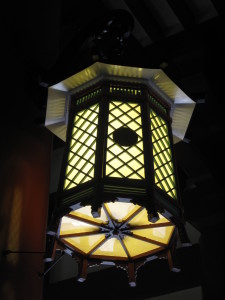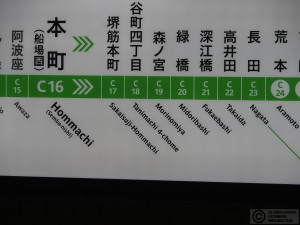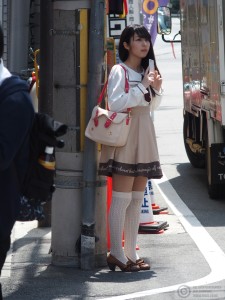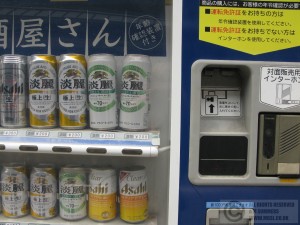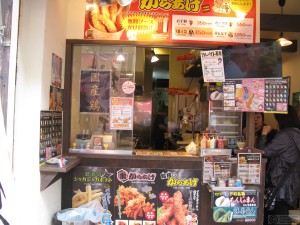It’s amazing. Impossibly beautiful gardens. Such care in making little things look pleasing. Design so restrained, simple, tasteful. Where there is ornamentation, such as carving on a temple, the colour scheme will be restricted – so unlike India or China where they throw in every colour they can. No hesitation in using technology to maximise convenience. Tasty food. Cheap alcohol. Everyone so polite and considerate. No litter or graffiti. No apparent vandalism or hooliganism. Little expectation of crime. What a great place to live…maybe.
But everywhere has its drawbacks. For a visitor the most obvious is the complex writing system – one ‘ordinary’ phonetic system, another completely different phonetic system for foreign words adopted into Japanese. And then if there is a Chinese character, use that instead, but perhaps with a few phonetic characters to make the meaning more precise. It’s not a problem for a tourist on the well beaten path as most signs are written in English too, but I suspect that travel in non-touristed areas might be challenging without the ability to read Japanese.
A problem that could affect a visitor, if their timing was unlucky, is Japan’s extreme susceptibility to earthquakes. It’s probably the best prepared country in the world, with strict building codes and regular drills (they’re even talking about putting collapsible portable toilets in lifts, because the if the power goes down people may be stuck in there for a long time) but when the next Big One hits Tokyo, it will still be a catastrophe with many deaths. Even if there’s no tsunami. And it’s due by 2017.
For Japanese women though, there are more immediate issues. Japan is the most backward of the developed countries when in comes to employment; if you want a career, you’d better not get married, because it will be assumed that you will have children and at that point you will leave work. So promotion opportunities for married women are virtually zero. So many decide not to marry, which means there is no point in dating. In any case something like 25% of young Japanese men and 45% of women have no interest in having a physical relationship, and the pressure of supporting a family on only their salary discourages men from marrying. Studies suggest that up to 40% of young Japanese women will remain childless, which may be good for the planet but has huge implications for Japanese society. Instead of growing into young women, girls stay little girls well into their 20s, giggling with their girlfriends in childish clothes.
But a childlike appearance doesn’t necessarily mean asexual in Japan. It seems to be perfectly acceptable for images of very young girls to be presented in a sexually provocative way, and for men to be interested in them. It all seems very unhealthy.
The other trait we noticed, which I think would irritate me greatly if I lived there, is the lack of initiative. A hotel duty manager who can’t accede to a guest’s request not to clean a room (that they will be vacating in less than 24 hours) without consulting head office? Seriously? When the woman at Kawagoe station was dripping blood everywhere, why was I the only person helping her, even though I couldn’t speak to her? The other Japanese passengers just looked on uncertainly. Once, when we were at the back of a bus, a young woman dropped her jacket as she was getting off. The passengers at the front must have noticed, but did they alert the driver or call out to the woman? Nope, they just sat there and let the bus drive off. It seems that adherence to rules and procedures is so rigid that when something happens that isn’t covered, they just don’t know how to react. Before we went to Japan we watched a TV program which featured a railway conductor whose actions had saved the lives of many passengers following the Great East Japan earthquake in 2011. His train had stopped near Sendai (the current on Japanese trains cuts out automatically if there’s an earthquake). According to procedure, he was supposed to lead his passengers to a stipulated assembly point, but he realised that in order to get there they would have to go downhill and across low ground. They were actually higher than the assembly point and it was safer to stay where they were. Good call – they would have been hit by the tsunami. But instead of being relieved at their escape, or suitably modest but a bit proud of his sound judgement, he was mainly really, really apologetic for having disobeyed the standing orders. It makes me wonder about those soldiers on remote islands who hid out for years after WWII ended. Was it heroism or patriotic fervour – or were they just blindly still following their last orders because doing otherwise was unthinkable? But I suppose the adherence to rules is what makes it such an orderly place.
There were other things that were different without being good or bad. The overstaffing made us laugh. Does every car park exit really need two flag-waving attendants to ensure that vehicles can make it across the pavement without mowing down pedestrians? Somehow we manage without carnage in the UK. Do queuing passengers at a busy city centre bus stop actually require a concierge to ensure they board in an orderly fashion? In China, probably, but not in Japan. There were shop assistants whose sole duty appeared to be bowing. I suppose it all contributes to a low unemployment rate, which is a good thing.
As someone accustomed to the ethnic kaleidoscope of the Thames Valley, the homogeneity of Japan was striking. It wasn’t just that everybody was Japanese (probably there were a fair sprinkling of Chinese and Korean people who I didn’t realise weren’t Japanese unless they spoke) but that hardly anybody had hair that wasn’t black (not even grey), or an extreme hairstyle, or facial hair, or tattoos, or piercings, or scruffy clothes.
And hardly anybody was overweight, not even a bit. We soon discovered that all Japanese food is not in fact light and healthy – that’s a myth. The shelves of convenience stores are stacked with sweet buns oozing sickly ‘cream’. Sugary soft drinks, beer and 8% alcopops are as popular as anywhere in the developed world. Tempura is deliciously crispy, but it is basically stuff fried in batter. Fatty grilled meat on a stick is the beer snack of choice. So how do they do it? No idea. Perhaps it’s portion control – you just can’t pile food into those exquisite little bowls and neat bento boxes they way you can on a 12″ dinner plate.
So would I want to live there? Probably not – the seismic risk would be the deal breaker. But I’d love to visit again.


